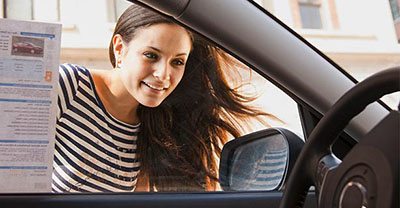New driver safety guide: Tips and best practices


0 min. read
If you’re new to the driver’s seat, getting from point A to point B can feel like a never-ending list of what-ifs. Learning to respond to situations quickly and safely on the road is the key. With a strong foundation and a lot of practice, you can become a confident, reliable driver. Explore Dairyland’s cheap car insurance options to find the coverage that fits your lifestyle and budget.
Build confidence with practice
Practice in a controlled setting is the best way to build competency and confidence behind the wheel. Make the most of your practice hours by:
Bringing an experienced driver along with you. They can coach you on proper hand placement, mirror checks, turn signals, speed limits, and other basics.
Talking through hypothetical driving scenarios. Have your passenger ask "what if" questions about dangerous conditions, obstacles on the road, mechanical issues, and responding to other vehicles.
Enroll in professional driving instruction. A structured course will cover the exact information on the written and practical tests—including the most up-to-date driving regulations.
The practical skills of driving are only a small part of the learning process. You also need awareness, focus, and communication with other drivers. Defensive driving gives you tools to identify risks early and evade hazards.

We’ve compiled our best advice for how to teach someone to drive.
Stay focused
Learn to constantly assess the road and surrounding conditions to identify potential hazards early and leave ample time and distance to react. Key aspects to scan for include:
Road conditions: Watch for slick spots, debris, potholes, and changing terrain.
Speed limits: Check for changes in speed zones as you drive.
Other vehicles: Continuously glance in your mirrors to monitor all cars around you. Be aware of anyone driving unsafely around you.
Pedestrians: Keep an eye out for people near the road, stopped cars or buses, crosswalks, and intersections.
Potential hazards: Look for tree limbs, animals, crashed vehicles, and anything encroaching on the road.
Blind spots
Even with properly adjusted mirrors, you won’t be able to see vehicles in certain areas beside or just behind you. This is especially true if you drive longer vehicles like trucks and SUVs.
Glancing over both shoulders should become a reflexive habit. It takes just a second and can help you avoid collisions during lane changes or merges.
Merging and turning
As you switch lanes, turn, or if you have to swerve, be sure to:
Briefly glance in the rearview and side mirrors for nearby cars that pose an immediate threat.
Then check the furthest blind spot over your right shoulder, scanning the rear blind zone on the passenger side.
Glance forward briefly, then quickly check the left blind spot over your left shoulder.
If it’s clear, signal and carefully make your move after another forward check.
Follow at a safe distance
The faster you go, the more space you should keep between yourself and vehicles in front of you. Leave at least 3 seconds between you and the next car while driving in town. At highway speeds, you may want to double that distance. Following too closely endangers everyone. If traffic suddenly slows or a hazard obstructs the road, you need time to react.

Aggressive drivers and road rage
Aggressive driving and road rage can take many forms. Here are some behaviors to watch out for:
Tailgating
Speeding
Brake-checking or cutting off other drivers
Erratic lane changing
Excessive yelling, honking, or gesturing
Preventing other cars from passing or changing lanes
If you spot an aggressive driver, check your surroundings so you can safely and properly respond to any unexpected behaviors. Concentrate on driving safely and resist the urge to engage or retaliate. Slow down or pull over if needed until they pass.
Driving in bad weather
If you can avoid driving in bad weather, do so, especially if you don’t have a lot of experience in the conditions. Be aware of these hazards that can arise from poor weather:

Low visibility
Rain, snow, fog, and even bright sunlight can affect both your ability to see and other drivers' ability to see you. If conditions reduce your visibility, pull over in a safe place and wait it out. Use your vehicle’s visors or a good pair of sunglasses to block out sun glare. Also, it’s a good habit to use your lights all the time, even in daylight.

Road conditions
Snow, ice, rain, and extreme heat can make roads harder to drive on. When the road is wet, your tires lose traction which can cause a skid on ice or hydroplaning in standing water. Ease off the accelerator and avoid abrupt steering and braking. If you lose control of your vehicle, gently steer in the direction your car is skidding until your tires grip the pavement again.
Heat can cause road materials to buckle, creating bumps or potholes. Slow down, increase your following distance, and pay attention to the road you’re driving on.

Driving while tired or fatigued
If you drive when you’re drowsy, your reaction time can bejust as impaired as a drunk driver’s on the road. Yawning, heavy eyes, wandering thoughts, or difficulty remembering the last few miles all signal it's time to stop at a rest area, or have someone take over driving.

Distracted driving
Keep your focus on the task at hand while you’re driving. It’s a demanding activity that can quickly become dangerous for you, your passengers, and other drivers. Phone use has become one of the biggest distractions to drivers, even prompting states to create laws that restrict drivers from using phones. Avoid distractions when you’re behind the wheel:
Loud music
Texting
Talking on the phone
Eating
Reaching for dropped items
Tending to children
The general information in this blog is for informational or entertainment purposes only. View our blog disclaimer.
*Data accuracy is subject to this article's publication date.










